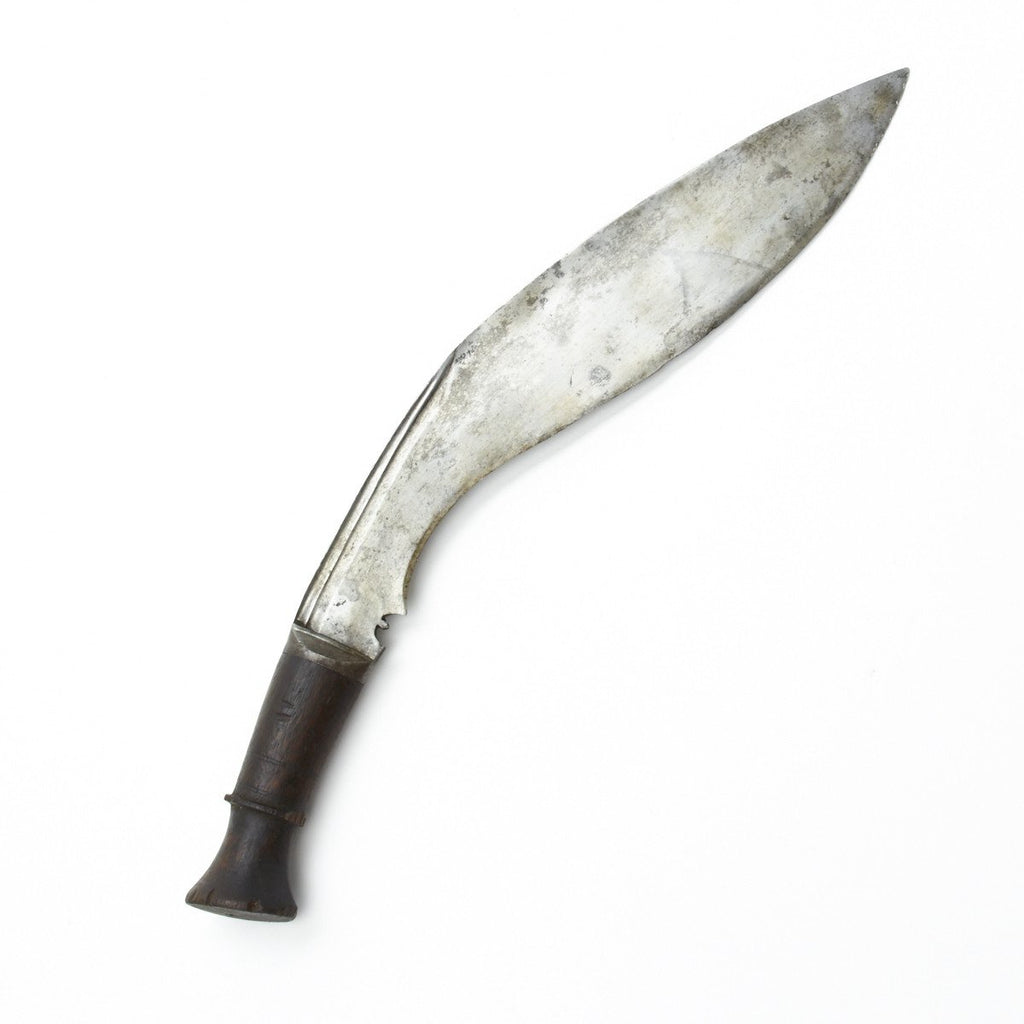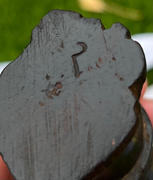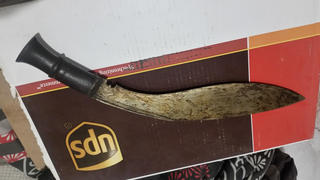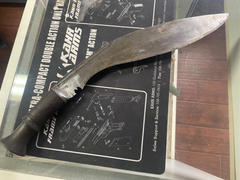Item Description
Original Item: The kukri is the national weapon of Nepal, traditionally serving the role of a basic utility knife for the Nepali-speaking Gurkhas, and consequently is a characteristic weapon of the Nepali Army as well as the Gurkha regiment in the British Military known as The Royal Gurkha Rifles who use the Kukri as part of their insignia.
The Gorkha Kukri is possibly the most recognizable and famous fighting knife ever developed. Indigenous to the mountain Kingdom of Nepal, home of the Gorkha who were "absorbed" into the British sphere of influence with the Treaty of Seguli in 1816. These ferocious fighters were infamous for their valor and for using the kukri an amazing "Tool of Death". It is a forward leaning leaf shaped blade, which provided the user with leveraged striking power. The kukri was became an everyday tool as much as it was a deadly weapon. Introduced long before the British arrived in the early 19th century, the Kukri became standard equipment for Gorkha Regiments serving in the British Army. Ironically the earliest Kukris are the largest, which seems improbable as improvements in nutrition and health care has resulted in mankind in general being much larger today than in 1800, yet with Kukris it is the exact reverse.
All of IMA's Kukris originate from our 2003 purchase of the Royal Nepalese Arsenal, which was located at the palace of Lagan Silekhana in Katmandu, Nepal. The purchase included a considerable number of military issue Kukris.
This style is the early Bhojpure Kukri that were typically produced at the turn of the 19th century and after. This style is a somewhat down scaled version of the Victorian Long Leaf kukri. It appears these saw service from the 1880's through the first quarter of the 20th century. Offered without scabbard.
ALL KNIVES -
- Arrive dirty packed in old original grease they are totally un-cleaned as found in
- Nepal after 100+ years in storage.
- Vary in size, most approximately 16" long, 2-1/2" wide, 3/8" thick.
- Vary in condition.
- Vary in appearance
- Wood Grips have minor cracks and/or small missing bits of wood.
- Are the real deal and are 100% genuine antique military issue knives, these are not tourist made reproductions.
Learn more here- Identifying and Collecting the Nepalese Military Kukri.
History of the Kukri-
The kukri (alternatively spelled khukri or khukuri) is a Nepalese knife with an inwardly curved edge, used as both a tool and as a weapon.
The kukri was, and in many cases still is, the basic and traditional utility knife of the Nepalese people. It is a symbolic weapon of the Nepalese Army, and of all Gurkha regiments throughout the world. It is a part of the regimental weaponry and heraldry of the Royal Gurkha Rifles, and is used in many traditional rituals among different ethnic groups of Nepal, including one where the groom wears one during the wedding ceremony. It is known to many people as simply the "Gurkha blade" or "Gurkha knife".
The pronunciation "kukri" is of Western origin, as the Nepalese people to whom this weapon belongs pronounce it with three syllables - "khukuri."
The oldest known kukris are in the National Museum in Kathmandu, Nepal that belonged to Drabya Shah, circa 1559. The kukri came to be known to the Western world when the East India Company came into conflict with the growing Gurkha Empire, culminating in the Gurkha War of 18141816. It gained literary attention in the 1897 novel Dracula by Irish author Bram Stoker. Despite the popular image of Dracula having a stake driven through his heart at the conclusion of a climactic battle between Dracula's bodyguards and the heroes, Mina's narrative describes his throat being sliced through by Jonathan Harker's kukri and his heart pierced by Quincey Morris' Bowie knife.
All Gurkha troops are issued with a kukri; in modern times members of the Brigade of Gurkhas receive training in its use. The kukri gained fame in the Gurkha War for its effectiveness. Its continued use through both World War I and World War II enhanced its reputation among both Allied troops and enemy forces. Its acclaim was demonstrated in North Africa by one unit's situation report. It reads: "Enemy losses: ten killed, ours nil. Ammunition expenditure nil." Elsewhere during the Second World War, the kukri was purchased and used by other British, Commonwealth and US troops training in India, including the Chindits and Merrill's Marauders. The notion of the Gurkha with his kukri carried on through to the Falklands War.
On September 2, 2010, Bishnu Shrestha, a retired Indian Army Gorkha soldier, alone and armed only with a kukri, defeated 40 bandits who attacked a passenger train he was on in India. He killed three of the bandits, wounded eight more and forced the rest of the band to flee.
PLEASE NOTE: SMALL IMPERFECTIONS LIKE MINOR CRACKS AND SMALL CHUNKS OF WOOD GRIPS SHOULD BE EXPECTED.
YOU MAY ALSO LIKE
- Reviews
- Questions
- knife
- blade
- condition
- kukri
- history
- piece
- grease
- handle
- Item
- shape
Nice piece of history
Knife was shipped fairly quickly, arrived well packaged. When cleaned up, it was just as described. In pretty good shape for its age and how it was stored. Very pleased with the purchase.
Original Nepalese fighting knife
The knife was excellent shape. Very sharp! This was the fifth item I have bought from IMA . I also have the 1837 and 1841 Brunswick rifles and the Gagendra rifle with bayonet!!! All of them have been a blast to clean up and display this unique part of history!!
A real piece of history,i love it, what it says it is
Great i called them and answered all my questions i had, great fast service, will buy this again,great present for that has everything.thank you ima
Excellent
Came shipped in protective packaging and knife was fully oiled. After washed and reoiled, knife is beautiful and well preserved. Thank you!
Original Nepalese Kukri Bhojpure Fighting Knife
Condition of this old knife was most excellent and I could not have hoped for a finer example than what I recieved. Thank You Much! rw
Exceeded my expectations
This Kukri was my first purchase from IMA and I was not disappointed. The Kukri I received was professionally packed and arrived very quickly. The condition was better than I had expected, and it cleaned up beautifully. Thanks IMA for a great purchase experience and an excellent piece of history!
Nice blade!
My Kukri was shipped quickly and was packaged very well. It had old grease dried on it from 110+ years in storage,but cleaned up nicely. It's in excellent condition except for a small chip on the grip. Nice piece of history!!
A solid, wonderful work of art.
Blade came to me well packed with both cardboard, tape, and packing grease. As for quality of the product, it had a couple nicks on the handle, but it’s excusable. The blade looked perfect, and still in great condition. After a couple passes with a honing rod, it sharpened up great and is now, admittedly terrifyingly sharp. As far as a field knife goes, I’m not sure if I would use this for anything other than self defense or chopping meat in a backyard. Unless someone can inform me otherwise, I’d err on the side of caution if you’re intending to use this for field work. I’d recommend buying a new, freshly made Kukri from Kukri House, and ensure you get a matching Kydex sheathe.
Exactly what I expected and cleaned up well!
It's a cool Kukri. As expected it came coated in grease, but the grease actually did protect it very well over the decades. Some elbow grease and soap was all that was needed to get it back to gleaming and it held it's edge over all these years. This was an excellent value for a historic, authentic Nepalese made Kukri.



















